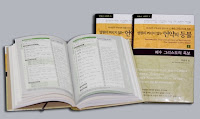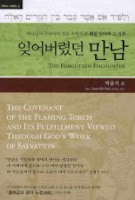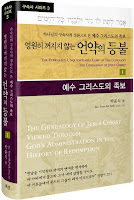(Hos 14:9) Whoever is wise, let him understand these things; [Whoever] is discerning, let him know them. For the ways of the LORD are right, And the righteous will walk in them, But transgressors will stumble in them.
(JER 9:12) Who is the wise man that may understand this? And [who is] he to whom the mouth of the LORD has spoken, that he may declare it? Why is the land ruined, laid waste like a desert, so that no one passes through?The Eternally Unquenchable Lamp of the Covenant
-Rev. Abraham PARK
<γεννάω>
of men who fathered children
of God making men his sons through faith in Christ's work
<τίκτω>
of a woman giving birth
(Rom 9:6) But [it is] not as though the word of God has failed. For they are not all Israel who are [descended] from Israel;
(Rom 9:7) neither are they all children because they are Abraham's descendants, but: "THROUGH ISAAC YOUR DESCENDANTS WILL BE NAMED."
(Rom 9:8) That is, it is not the children of the flesh who are children of God, but the children of the promise are regarded as descendants.
(Gal 3:15) Brethren, I speak in terms of human relations: even though it is [only] a man's covenant, yet when it has been ratified, no one sets it aside or adds conditions to it.
(Gal 3:16) Now the promises were spoken to Abraham and to his seed. He does not say, "And to seeds," as [referring] to many, but [rather] to one, "And to your seed,"
In the genealogy of Matthew chapter 1, there are “γεννάω” 40 times.
These are active voices 39 times, but only one time in Matthew 1:16, it is a passive voice.
(Mtt 1:16) and to Jacob was born Joseph the husband of Mary, by whom was born Jesus, who is called Christ.
* ἐγέννησεν: γεννάω: begat: verb - aorist active indicative - third person singular
* ἐγεννήθη: γεννάω: was born: verb - aorist passive indicative - third person singular
(Mtt 1:3) and to Judah were born Perez and Zerah by Tamar; and to Perez was born Hezron; and to Hezron, Ram;
(Mtt 1:4) and to Ram was born Amminadab; and to Amminadab, Nahshon; and to Nahshon, Salmon;
(Mtt 1:5) and to Salmon was born Boaz by Rahab; and to Boaz was born Obed by Ruth; and to Obed, Jesse;
(Mtt 1:6) and to Jesse was born David the king. And to David was born Solomon by her [who had been the wife] of Uriah;
Judah - Perez - Hezron – Ram – Amminadab – Nahshon – Salmon – Boaz
During the 400 years of slavery, only four generations left, but there are 10 generations from Ephraim to Joshua even though the period was shorter.
1) Hezron – 2) Ram – 3) Amminadab – 4) Nahshon
1) Ephraim – 2) Beriah – 3) Resheph – 4) Telah – 5) Tahan – 6) Ladan – 7) Ammihud – 8) Elishama – 9) Nun – 10) Joshua
1. Between Ram and Amminadab: 400 years of blank.
2. Between Salmon and Boaz: 300 years of blank.
3. Between Joram and Achaz: 3 Kings are omitted.
4. Between Josias and Jechoias: 4 Kings are omitted.
1. Between Ram and Amminadab: 400 years of blank.
BC 1876, 70 family members of Jacob entered Egypt and met Joseph.
(Jacob 130 years old, Joseph 40 years old)
(Gen 46:12) The sons of Judah: Er and Onan and Shelah and Perez and Zerah (but Er and Onan died in the land of Canaan). And the sons of Perez were Hezron and Hamul.
Hezron is the father of Ram.
(1CH 2:9) Now the sons of Hezron, who were born to him [were] Jerahmeel, Ram, and Chelubai.
l BC 1446, Exodus: After 430 years, Israel escaped from Egypt.
l BC 1446: The 11th camp site in the journey of Wilderness: Wilderness of Sinai
In the Wilderness of Sinai, the first Census of soldiers was taken. At that time, Nashon and Elishama was the head of their father’s household.
(Num 1:2-4) "Take a census of all the congregation of the sons of Israel, by their families, by their fathers' households, according to the number of names, every male, head by head from twenty years old and upward, whoever is able to go out to war in Israel, you and Aaron shall number them by their armies. "With you, moreover, there shall be a man of each tribe, each one head of his father's household.
Among 12 tribes, the head of Judah's household was Nahshon, and the head of Ephraim's household was Elishama.
(Num 1:7) of Judah, (9th)Nahshon the son of Amminadab;
(Num 1:10) of the sons of Joseph: of Ephraim, Elishama the son of Ammihud; of Manasseh, Gamaliel the son of Pedahzur;
Aminnadab is the biological father of Nashon.
Because Aaron died in BC 1407, a year before entering Canaan, Aaron was born in BC 1530.
(Num 33:38) And Aaron was one hundred twenty-three years old when he died on Mount Hor.
And the leader and the high priest Aaron married Elisheba, thus Amminadab was the father-in-law of Aaron.
(Exo 6:23) Aaron married Elisheba, the daughter of Amminadab, the sister of Nahshon, and she bore him Nadab and Abihu, Eleazar and Ithamar.
So, Moses, Aaron, Amminadab, Nashon might live together.
Salmon is the person who worked with Joshua.
2. Between Salmon and Boaz: 300 years of blank.
(Joshua 2:1) Then Joshua the son of Nun sent two men as spies secretly from Shittim, saying, "Go, view the land, especially Jericho " So they went and came into the house of a harlot whose name was Rahab, and lodged there.
BC 1407: After 40 years in the Wilderness, in the Plains of Moab(Shittim), the 41st camp site, Joshua sent spies. One of two spies, Salmon married Rahab. Salmon was 2nd generation who was born in the Wilderness.
Boaz and Ruth lived in the last period of judges. In the 3rd book page 170, it is said the famine in Bethlehem was punishment for sin. Mahlon means ‘sick’ and Chilion means ‘pining, destruction’.
(Ruth 1:1) Now it came about in the days when the judges governed, that there was a famine in the land. And a certain man of Bethlehem in Judah went to sojourn in the land of Moab with his wife and his two sons.
(Ruth 1:2) The name of the man was Elimelech, and the name of his wife, Naomi; and the names of his two sons were Mahlon and Chilion, Ephrathites of Bethlehem in Judah. Now they entered the land of Moab and remained there.
(Ruth 1:4) Then They took for themselves Moabite women as wives; the name of the one was Orpah and the name of the other Ruth. And they lived there about ten years.
(Ruth 1:6) Then she arose with her daughters-in-law that she might return from the land of Moab, for she had heard in the land of Moab that the LORD had visited His people in giving them food.
(Judges 11:26) 'While Israel lived in Heshbon and its villages, and in Aroer and its villages, and in all the cities that are on the banks of the Arnon, three hundred years, why did you not recover them within that time?
Israel arrived at Gilgal January 10th in BC 1406. Therefore three hundred years mentioned by Jephathah started in BC 1406, and ended in BC 1106. If we calculate the 300 years by the number of years, it can be BC 1104. It perfectly fits with the chronology of the period of the Judges (The 3rd book, 214p).
(Ruth 4:21) and to Salmon was born Boaz, and to Boaz, Obed,
(Ruth 4:22) and to Obed was born Jesse, and to Jesse, David.
(Joshua 24:31) Israel served the LORD all the days of Joshua and all the days of the elders who survived Joshua, and had known all the deeds of the LORD which He had done for Israel.
(Judges 2:10) All that generation also were gathered to their fathers; and there arose another generation after them who did not know the LORD, nor yet the work which He had done for Israel.
(1SAM 16:13) Then Samuel took the horn of oil and anointed him in the midst of his brothers; and the Spirit of the LORD came mightily upon David from that day forward. And Samuel arose and went to Ramah.
BC 1010: David became the King of Judah in Hebron.
BC 1003: After David reigned 7 years and 6 months in Hebron, he became the King of United Israel in Jerusalem.
3. Between Joram and Achaz: 3 Kings are omitted.
(Mat 1:8) Asa was the father of Jehoshaphat, Jehoshaphat the father of Joram, and Joram the father of Uzziah.
(1CH 3:11) Joram his son, Ahaziah his son, Joash his son,
(1CH 3:12) Amaziah his son, Azariah his son, Jotham his son,
Uzziah was also called Azariah.
(2King 15:17) In the thirty-ninth year of Azariah king of Judah, Menahem son of Gadi became king over Israel and reigned ten years in Samaria.
The common point of three kings who were omitted was that they served the idols. They are all related to the evil king Ahab and his wife Jezebel, and her daughter Athaliah. Ahab, Jezebel, and Athaliah were the authors (ringleaders) who tried to destroy all the royal offspring and to break off the God’s history of redemption.
(2KI 8:26) Ahaziah was twenty-two years old when he became king, and he reigned one year in Jerusalem. And his mother's name was Athaliah the granddaughter of Omri king of Israel.
(2CH 22:10) Now when Athaliah the mother of Ahaziah saw that her son was dead, she rose and destroyed all the royal offspring of the house of Judah.
It is a fulfillment of prophecy of Elijah.
(1KI 21:21) "Behold, I will bring evil upon you, and will utterly sweep you away, and will cut off from Ahab every male, both bond and free in Israel;
(1KI 21:25) Surely there was no one like Ahab who sold himself to do evil in the sight of the LORD, because Jezebel his wife incited him.
1) Ahaziah
(2CH 22:3) Ahaziah was twenty-two years old when he became king, and he reigned one year in Jerusalem. And his mother's name was Athaliah, the granddaughter of Omri.
2) Amaziah
(2CH 25:14) Now after Amaziah came from slaughtering the Edomites, he brought the gods of the sons of Seir, set them up as his gods, bowed down before them and burned incense to them.
3) Joash
(2CH 24:18) They abandoned the house of the LORD, the God of their fathers, and served the Asherim and the idols; so wrath came upon Judah and Jerusalem for this their guilt.
(2CH 24:22) Thus Joash the king did not remember the kindness which his father Jehoiada had shown him, but he murdered his son. And as he died he said, "May the LORD see and avenge!"
4. Between Josias and Jechoias: 4 Kings are omitted.
We set aside Athaliah, the queen.
(Mat 1:11) Josiah became the father of Jeconiah and his brothers, at the time of the deportation to Babylon.
1) Joahaz
2) Jehoiakim
3) Zedekiah
(2CH 36:1) Then the people of the land took Joahaz the son of Josiah, and made him king in place of his father in Jerusalem.
Joahaz was also called Shallum.
(JER 22:11) For thus says the LORD in regard to Shallum the son of Josiah, king of Judah, who became king in the place of Josiah his father, who went forth from this place, "He will never return there;
(2CH 36:5) Jehoiakim was twenty-five years old when he became king, and he reigned eleven years in Jerusalem; and he did evil in the sight of the LORD his God.
(1CH 3:15) The sons of Josiah were Johanan the firstborn, and the second was Jehoiakim, the third Zedekiah, the fourth Shallum.
Jeconiah was the son of Jehoiakim and the grandson of Josiah. Joahaz, Jehoiakim, and Zedekiah were brothers. They all disobeyed to God’s commandment to surrender to Babylon.



